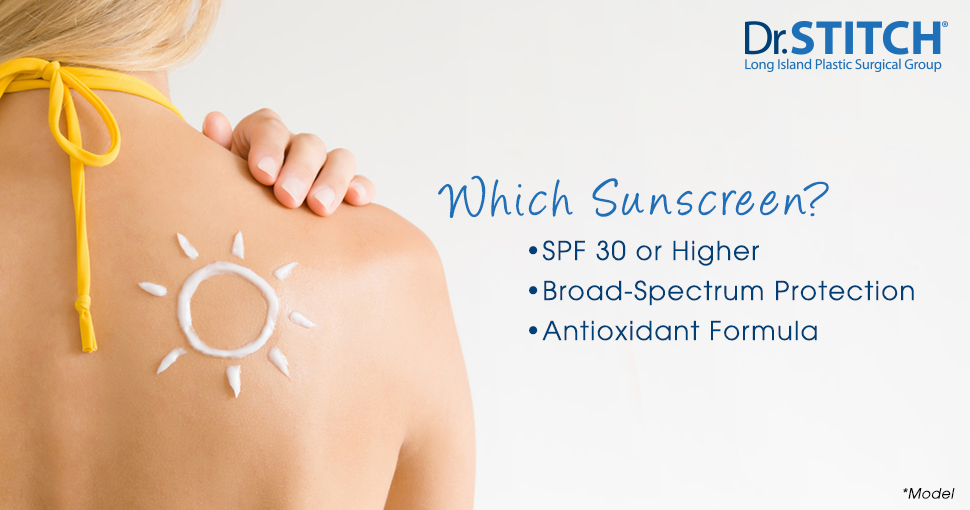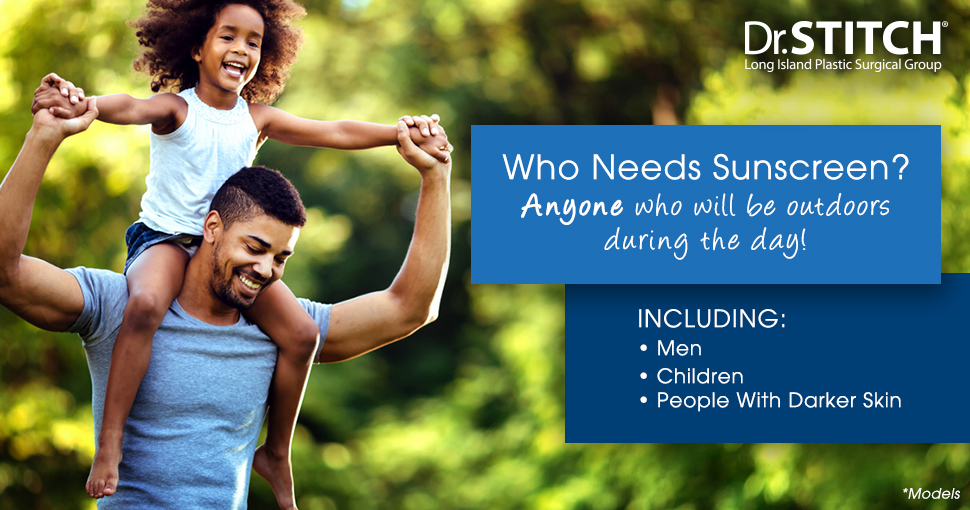Summer is here and at Dr.STITCH we are excited for ice cream trucks, beach time, longer days, and SUNSCREEN! That’s right, we’re passionate about helping you keep your family safe, and that includes keeping you safe from the harmful damage that can result from unprotected sun exposure. In fact, when it comes to sunscreen, the season doesn’t even matter. Sun protection should be a year-round concern.
Why is sunscreen so important? According to The Skin Cancer Foundation, more than 9,000 Americans are diagnosed with skin cancer every single day.1 Some people don’t realize how harmful sun damage can be, but the truth is that people die of skin cancer at a rate of 2 people per hour in the U.S.2 It is especially important to protect children because they have skin that is more delicate and prone to burning. Read our DOs and DON’Ts for tips to stay safe in the sun.
Five Sunscreen Rules to Follow
DO use broad-spectrum sunscreen with antioxidants and UVA and UVB protection
With so many different brands, types, and SPF levels available, choosing a sunscreen can be overwhelming. Here are a few guidelines to help you get the best protection for your family:
- Sunscreens labeled “broad-spectrum” will protect against both UVA and UVB rays
- Use a minimum SPF of 30
- A formula with added antioxidants can give you an extra defense against skin damage
- Zinc based formulas may work best for sensitive skin

DO apply early, often, and everywhere
Sunscreen should be applied BEFORE you go outdoors and it is important to focus on more than just your face. Make sunscreen part of your morning routine and don’t forget to apply to ears, hands, arms, legs, and scalp. On beach days, apply sunscreen before you put on your swimsuit to guard against burns along the edges of your suit. Reapply the full amount every two hours and after swimming or sweating.
DO remind the men in your life to use sunscreen
Studies show that women are twice as likely to apply sunscreen than men; in fact, only 15% of men use sunscreen regularly.3 Encourage the guys in your life to make sunscreen part of their routine and make sure that dads know how to apply sunscreen properly to their kids.
DO use sunscreen on any healing lacerations, burns, and other injuries
There is a myth that the sun will help heal wounds. Sun exposure can actually prevent wounds from healing properly, can increase the likelihood of scarring, and can make existing scars appear darker. Be sure to thoroughly cover scars and healing wounds with sunscreen or clothing that has Ultraviolet Protection Factor (UPF).
DO buy sunscreen that you love
It is easier to stick to a good habit when you enjoy it. If you don’t like the scent or texture of your sunscreen, you’ll be less likely to use it. Try different broad-spectrum sunscreen options to find one that you like best. Sun protection is a critical part of your health routine, so don’t be afraid to invest in a high-quality sunscreen. ProBLUE MD Pure Protection Sunscreen is a favorite at Dr.STITCH. This antioxidant enriched formula is water resistant, absorbs quickly, and features a spray applicator that makes it easy to cover burn-prone spots like the scalp.

Five Things You Should Never Do With Sunscreen
DON’T rely on sunscreen alone
Sunscreen is a must, but it cannot fully protect in all situations. You’ll also want these items in your sun protection arsenal:
- UV protective sunglasses because eyelids are delicate and it is important not to put sunscreen too close to eyes, especially for little ones. Make sure everyone has sunglasses that are rated UV400 or higher.
- Swim shirts or rashguards with UPF fabric can keep skin safe during long swimming sessions.
- Hats are necessary if you exercise outdoors, even with sweatproof sunscreen. A hat with UPF material can provide extra protection.
DON’T think you’re safe just because you don’t burn
Common misconceptions about sunscreen include the idea that people with naturally darker skin types do not need sunscreen and the idea that no one needs sunscreen later in the afternoon. The truth is that the UVA and UVB rays that cause skin cancer, as well as visible signs of aging, affect everyone. No one is immune to sun damage, even if you don’t burn easily. UVA and UVB rays can damage your skin any time during the day, even when it is cloudy or overcast, so reach for sunscreen no matter the forecast!
DON’T rely on the SPF in your makeup
Makeup that contains SPF is a great backup to your usual sunscreen, but it should not be your primary sun protection. People typically do not apply enough makeup to get adequate protection. Plus, you should have sun protection for all exposed areas anytime you will be outdoors for more than 15 minutes – not just the face.
DON’T forget to check the expiration date
It is important to pay attention to the expiration date printed on the label of every sunscreen product. Expired sunscreen will not protect you from harmful UVA and UVB rays. Be extra careful with children’s sunscreen, as kids may not realize that they are burning until it is too late.
DON’T save sunscreen just for the beach
Sunscreen should definitely be in your beach bag (in fact, we often pack a cream, a spray, and a stick to make sure everyone is covered for a day in the sun.) However, it should also be a frequently used product that is well-stocked in your home throughout the year. Sunscreen should be applied before running errands, playing outside, or taking a walk – in every season.

Stay Safe in the Sun and Call Dr.STITCH if You Need Us!
We hope that all your outdoor adventures are fun and safe! Dr.STITCH is an on-call service for the immediate treatment of lacerations, burns, complex wounds, facial trauma, and hand injuries, and is staffed by the experienced plastic surgeons at Long Island Plastic Surgical Group. Learn more about how Dr.STITCH works or download our contact card to keep handy.
1 https://www.skincancer.org/skin-cancer-information/skin-cancer-facts
2 https://www.cancer.org/research/cancer-facts-statistics/all-cancer-facts-figures/cancer-facts-figures-2019.html
3 Holman DM, Berkowitz Z, Guy GP, Jr., Hawkins NA, Saraiya M, Watson M. Patterns of sunscreen use on the face and other exposed skin among U.S. adults.External Journal of the American Academy of Dermatology 2015;73(1):83–92 e81.
